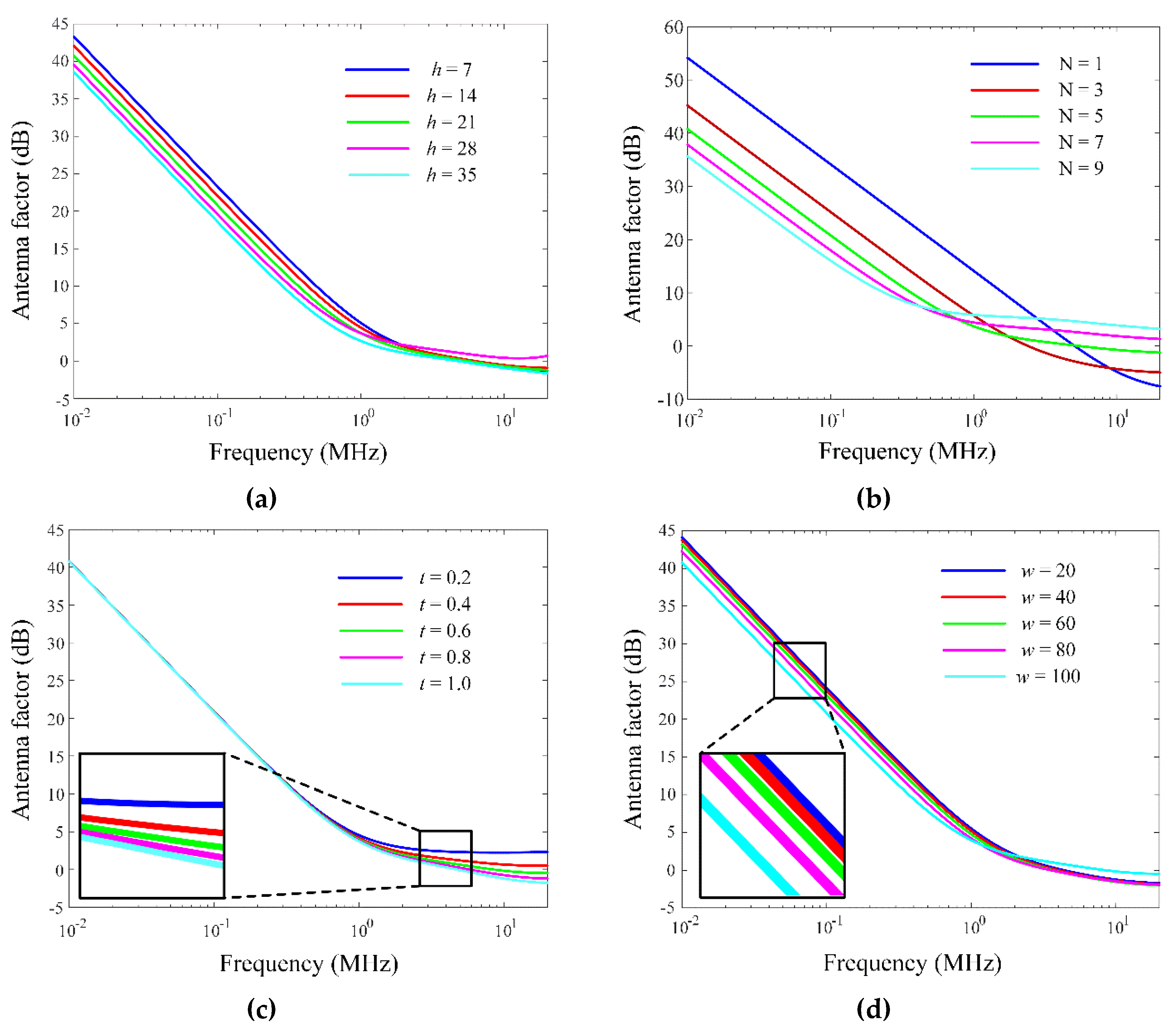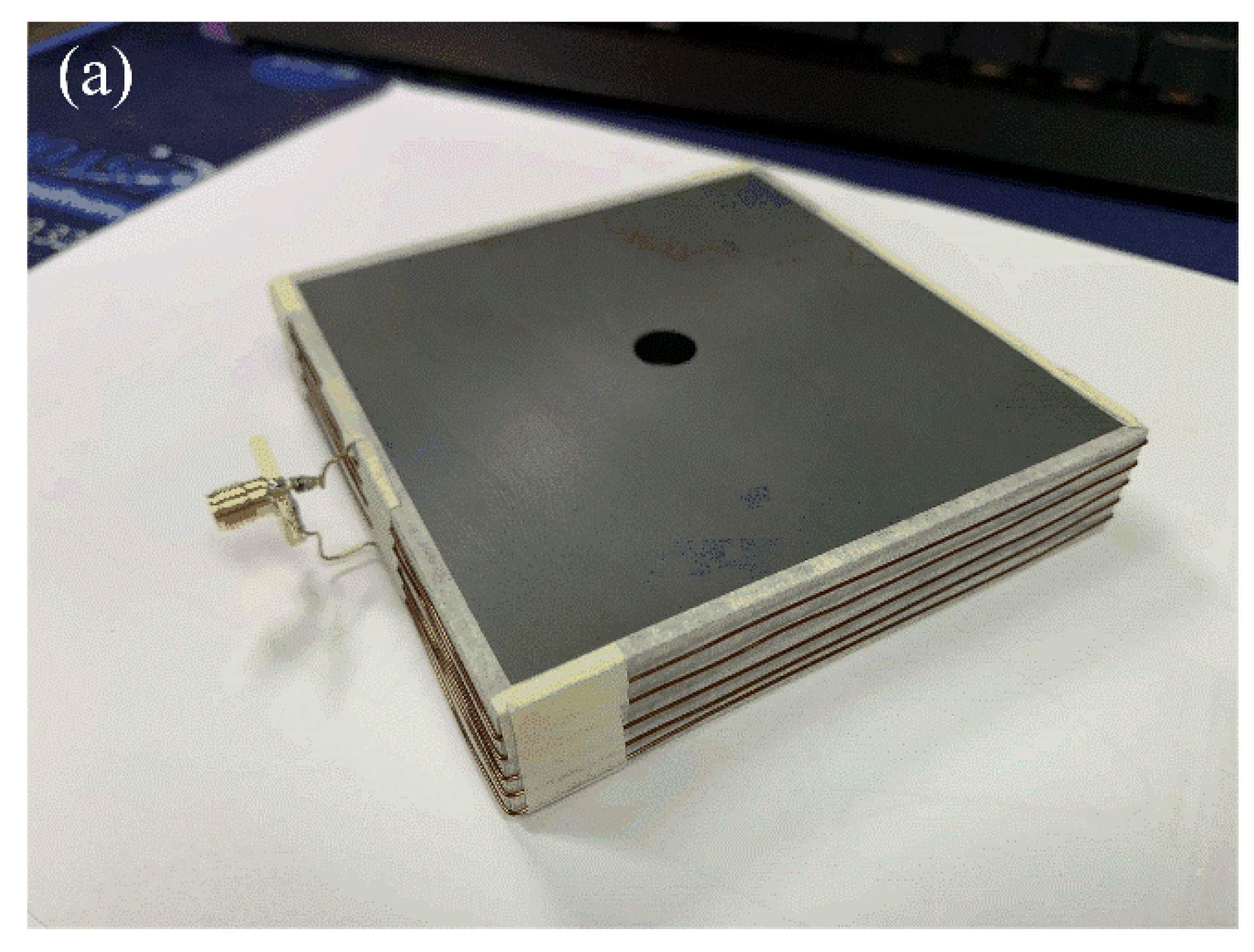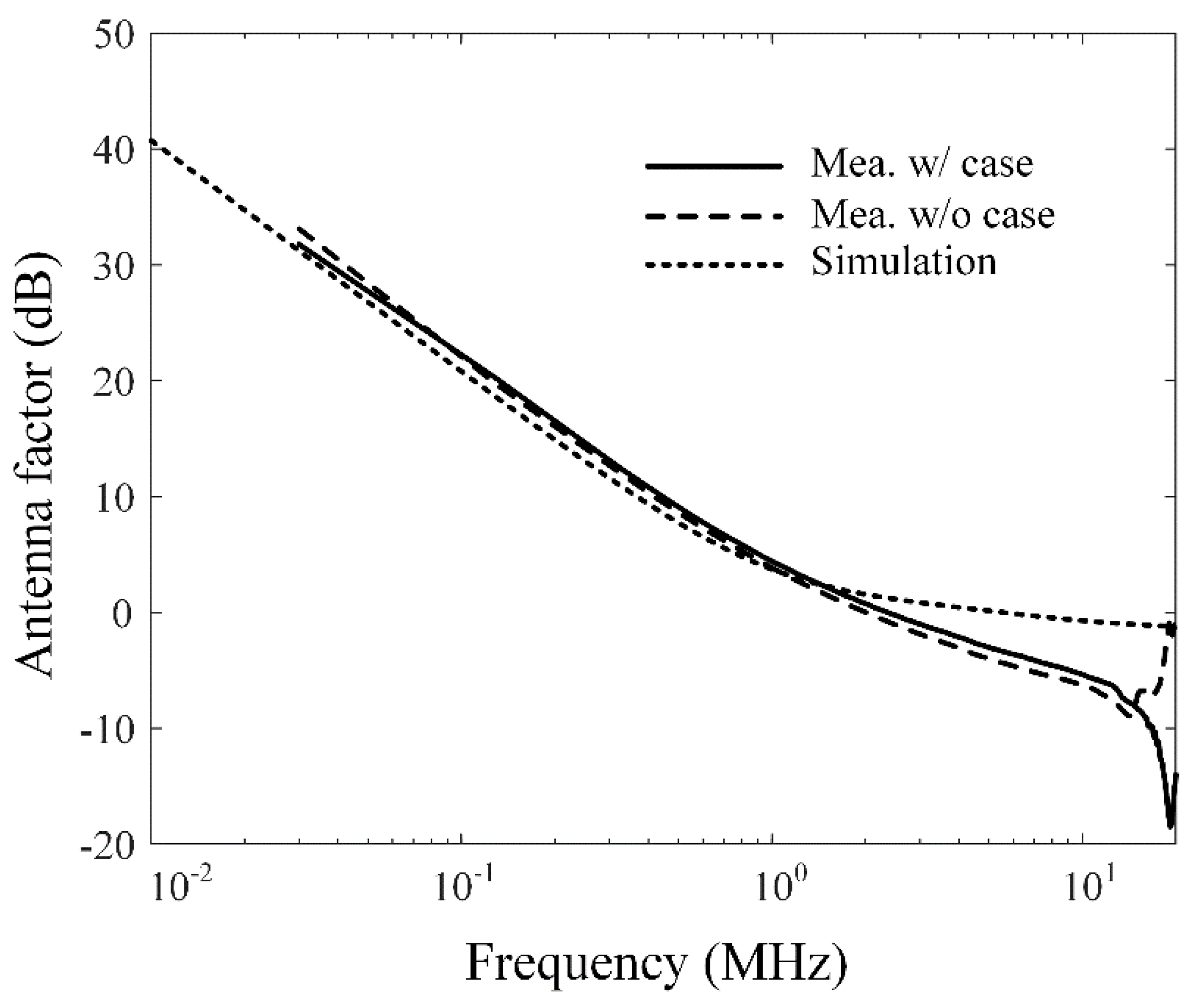Design of a Miniaturized Rectangular Multiturn Loop Antenna for Shielding Effectiveness Measurement
Abstract
:1. Introduction
2. Proposed Antenna and Theory
2.1. Theoretical Background
2.2. Proposed Antenna Structure and Simulation
3. Antenna Fabrication and Measured Results
4. Conclusions
Author Contributions
Funding
Conflicts of Interest
References
- Marcello, D.A.; Maria, S.S. Theoretical and experimental characterization of the EMP−interaction with composite-metallic enclosures. IEEE Trans. Electromagn. Compat. 2000, 42, 152–163. [Google Scholar]
- Qi, F.L.; Wen, Y.Y.; Ming, F.X.; Jun, F.M.; Liu, Q.H. Shielding characterization of metallic enclosures with multiple slots and a thin-wire antenna loaded: Multiple oblique EMP incidences with arbitrary polarizations. IEEE Trans. Electromagn. Compat. 2009, 51, 284–292. [Google Scholar]
- Lim, N. Conductive concrete structure for EMP protection of critical infrastructure facilities. Lett. Electromagn. Compat. Pract. Appl. 2019, 1, 26–33. [Google Scholar]
- Qingguo, W.; Erwei, C.; Zhaoming, Q. On the shielding effectiveness of small-dimension enclosures using a reverberation chamber. IEEE Trans. Electromagn. Compat. 2011, 53, 562–569. [Google Scholar]
- Christopher, L.H.; David, A.H.; Marco, S.; John, M.L.; Jason, C.; Galen, K.; Andrew, C.M.; Yuhui, H. Use of reverberation chambers to determine the shielding effectiveness of physically small, electrically large enclosures and cavities. IEEE Trans. Electromagn. Compat. 2008, 50, 770–782. [Google Scholar]
- Zhou, C.; Gui, L.; Liu, D.; Lv, L.; Lu, D.; Lang, L. Simulation and measurement for shielding effectiveness of small size metal enclosure. IET Sci. Meas. Technol. 2017, 11, 25–29. [Google Scholar]
- Ali, S.; Mojtaba, J. Shielding effectiveness measurement for extremely small dimension enclosures. IEEE Trans. Electromagn. Compat. 2019, 61, 1740–1745. [Google Scholar]
- Sebastiano, D.F.; Mirko, M.; Bernardo, T.; Carmine, Z. Shielding effectiveness measurements for ferromagnetic shields. IEEE Trans. Instrum. Meas. 2009, 58, 115–121. [Google Scholar]
- Yessica, A.; Andrew, H.; Oliver, C.L. Evaluation of near-field electromagnetic shielding effectiveness at low frequencies. IEEE Sens. J. 2019, 19, 121–128. [Google Scholar]
- Amin, F.; Mohamed, B.; Fabrice, D.; Nabil, B.; Frederic, L.; Lionel, P. A new methodology to predict the magnetic shielding effectiveness of enclosures at low frequency in the near field. IEEE Trans. Magn. 2015, 51, 1–4. [Google Scholar]
- Moser, J.R. Low-Frequency Low Impedance Electromagnetic Shielding. IEEE Trans. Electromagn. Compat. 1988, 30, 202–210. [Google Scholar] [CrossRef]
- Han, H.L.; Jae, W.L.; Jong, H.K.; Jong, H.H.; Chang, H.H. Prediction of radio-wave propagation in a shield room: Measurement, simulation, and theoretical method. J. Electromagn. Eng. Sci. 2020, 20, 45–54. [Google Scholar]
- Soyeon, K.; Hyunchul, S. An Ultra-Wideband Conformal Meandered Loop Antenna for Wireless Capsule Endoscopy. J. Electromagn. Eng. Sci. 2019, 19, 101–106. [Google Scholar]
- A.H. Systems, Inc. SAS-563P. Available online: https://www.ahsystems.com/catalog/SAS-563B.php (accessed on 30 October 2019).
- Zahid, Z.; Qu, L.; Kim, H.H.; Kim, H. Circularly polarized loop-type ground radiation antenna for IoT applications. J. Electromagn. Eng. Sci. 2019, 19, 153–158. [Google Scholar] [CrossRef] [Green Version]
- Dohoon, K.; Yongjin, K. Small low-profile loop wideband antennas with unidirectional radiation characteristics. IEEE Trans. Antennas Propag. 2007, 55, 72–77. [Google Scholar]
- Guangping, Z.; Glenn, S.S. The multiturn half-loop antenna. IEEE Trans. Antennas Propag. 1994, 42, 750–754. [Google Scholar]
- Lingnan, S.; Yahya, R.S. Miniaturized loop antennas for wireless brain-machine interfaces: Efficiency enhancement and link characterizations. In Proceedings of the Antennas and Propagation (APSURSI), 2016 IEEE International Symposium, Fajardo, Puerto Rico, 26 June–1 July 2016; pp. 879–880. [Google Scholar]
- Kin, L.W.; Wei, Y.C.; Ting, W.K. On-board printed coupled-fed loop antenna in close proximity to the surrounding ground plane for penta-band WWAN mobile phone. IEEE Trans. Antennas Propag. 2011, 59, 751–757. [Google Scholar]
- Liu, H.; Cheng, Y.; Yan, M. Electrically small loop antenna standing on compact ground in wireless sensor package. IEEE Antennas Wirel. Propag. Lett. 2011, 10, 438–441. [Google Scholar]
- Pavel, T.; Irina, M.; Michail, D.; Orest, V.; Irina, V. Electrically small loop antennas for RFID applications. IEEE Antennas Wirel. Propag. Lett. 2015, 14, 1786–1789. [Google Scholar]
- Gokhan, M.; Saurabh, G.; Kubilay, S.; John, L.V. Small wideband double-loop antennas using lumped inductors and coupling capacitors. IEEE Trans. Antennas Propag. 2011, 10, 107–110. [Google Scholar]
- He, D. PT-level high-sensitivity magnetic sensor with amorphous wire. Sensors 2019, 20, 161. [Google Scholar] [CrossRef] [Green Version]
- Spyridon, S.; Adyl, M.E.G.; Fabien, M.; Philippe, P. Fabrication and characterization of a flexible fluxgate sensor with pad-printed solenoid coils. Sensors 2020, 20, 2275. [Google Scholar] [CrossRef] [Green Version]
- Brian, B.T.; Anthony, G. Planar shielded-loop resonators. IEEE Trans. Antennas Propag. 2014, 62, 3310–3320. [Google Scholar]
- Mani, K.; Kamal, S. An accurate circuit model for input impedance and radiation pattern of two-port loop antennas as E-and H-probe. IEEE Trans. Antennas Propag. 2017, 65, 114–120. [Google Scholar]
- Rong, L.L.; Gerald, D.; Joy, L.; Manos, M.T. Investigation of circularly polarized loop antennas with a parasitic element for bandwidth enhancement. IEEE Trans. Antennas Propag. 2005, 53, 3930–3938. [Google Scholar]
- Ofer, A. Moebius loop antenna system stability analysis under parameters variation. In Proceedings of the IEEE International Conference on Microwaves, Antennas, Communications and Electronic Systems, Tel-Aviv, Israel, 13–15 November 2017; pp. 1–5. [Google Scholar]
- FEKO EM Simulation Software, Altair Engineering Inc. Available online: http://www.altair.co.kr (accessed on 30 September 2003).
- Constantine, A.B. Antenna Theory Analysis and Design, 3rd ed.; Wiley-Interscience: Manhattan, NY, USA, 2005; pp. 245–246. [Google Scholar]
- Boris, L. Field of a rectangular loop. IEEE Trans. Antennas Propag. 2004, 52, 948–952. [Google Scholar]
- Masanori, I.; Koji, K. A simple method by measuring the impedance for evaluation of magnetic antenna factor of a loop antenna. IEICE Electron. Express 2006, 3, 92–96. [Google Scholar]
- Masanori, I.; Koji, K. Impedance method for a shielded standard loop antenna. IEEE Trans. Instrum. Meas. 2007, 56, 422–425. [Google Scholar]
- ETS-lindgren. 6512. Available online: http://www.ets-lindgren.com/datasheet/antennas/loops/4009/400905 (accessed on 28 April 2016).
- TDK RF Solutions. LP-0930P. Available online: https://www.tdkrfsolutions.tdk.com/products/loop-antennas/passive-loop-antenna-lp-0930p (accessed on 30 May 2016).









| Parameters | Values |
|---|---|
| t | 1 mm |
| g | 4 mm |
| h | 21 mm |
| w | 100 mm |
| d | 10 mm |
| N | 5 turns |
| Antenna | Frequency | Dimension (mm) | AF (@30kHz) |
|---|---|---|---|
| [10] | 9 kHz–10 MHz | 60 × 60 × 6 | - |
| [30] | 1 MHz–30 MHz | 152 × 152 × 3.7 | - |
| A.H. system (SAS-563P) [14] | 10 kHz–30 MHz | 300 × 300 | 28 dB |
| ETS-lindgren (6512) [34] | 9 kHz–30 MHz | 600 × 600 × 38 | 27 dB |
| TDK (LP-0930P) [35] | 9 kHz–30 MHz | 600 × 600 | 21 dB |
| Proposed Ant. | 10 kHz–30 MHz | 100 × 100 × 21 | 31.8 dB |
© 2020 by the authors. Licensee MDPI, Basel, Switzerland. This article is an open access article distributed under the terms and conditions of the Creative Commons Attribution (CC BY) license (http://creativecommons.org/licenses/by/4.0/).
Share and Cite
Youn, S.; Lim, T.H.; Kang, E.; Lee, D.H.; Kim, K.B.; Choo, H. Design of a Miniaturized Rectangular Multiturn Loop Antenna for Shielding Effectiveness Measurement. Sensors 2020, 20, 3178. https://doi.org/10.3390/s20113178
Youn S, Lim TH, Kang E, Lee DH, Kim KB, Choo H. Design of a Miniaturized Rectangular Multiturn Loop Antenna for Shielding Effectiveness Measurement. Sensors. 2020; 20(11):3178. https://doi.org/10.3390/s20113178
Chicago/Turabian StyleYoun, Sangwoon, Tae Heung Lim, Eunjung Kang, Dae Heon Lee, Ki Baek Kim, and Hosung Choo. 2020. "Design of a Miniaturized Rectangular Multiturn Loop Antenna for Shielding Effectiveness Measurement" Sensors 20, no. 11: 3178. https://doi.org/10.3390/s20113178
APA StyleYoun, S., Lim, T. H., Kang, E., Lee, D. H., Kim, K. B., & Choo, H. (2020). Design of a Miniaturized Rectangular Multiturn Loop Antenna for Shielding Effectiveness Measurement. Sensors, 20(11), 3178. https://doi.org/10.3390/s20113178





